We make the foundation with our own hands
Let's dwell on the main points of the question of how to make a columnar foundation from PVC pipes on your own. It is possible to make such a foundation without using the labor of professionals, but for this a number of conditions must be observed:
- First, the site for construction must be correctly selected. He should not have strong differences in height. A flat area would be ideal.
- Secondly, the place for the foundation must be prepared in advance. To do this, the land for the site must be cleared of debris and objects on it.
- The next step will be to mark the site for installing polypropylene pipes.
- In order for the calculations of the number and location of the supports to be correct, it is imperative to take into account what size the building will be, what loads it will create. It is also necessary to take into account the features that the soil possesses at the site of the future construction. It is good if you have an opinion on the geological features of your area.
- The next step will be drilling wells for supporting pipes. This can be done with a gasoline auger or a hand auger. It should be borne in mind that the supports will be located at a distance of 1.5-2 meters from one another. It is imperative to provide additional reinforcement where there will be additional loads in the building.
- The well can be of different diameters. It depends on what diameter the PVC pipe will be used. It usually comes in a diameter of 150 to 250 mm.
- The well is drilled with a widened bottom filled with sand and gravel.
- Waterproofing is laid on sand and gravel. Roofing material is used as waterproofing, but other materials can also be used.
- Pipes are installed in the prepared wells, and then concrete is poured into them with the addition of fine crushed stone. Before the concrete hardens, metal reinforcement is installed in it, selected based on the structural features of the structure, as well as future loads.
- To increase the rigidity of the structure, a solid continuous strapping is installed on the pipes, which is called a grillage. It connects all the supports and redistributes the weight of the building. Monolithic concrete, metal beams are used as a grillage, as well as a wooden beam and reinforced concrete lintels.
- In order to have good adhesion to the grillage, on each support from the pipe, outlets of steel rods are left in its upper part.
- The installation of the grillage and its connection with other elements takes place in accordance with the selected design.
- To prevent groundwater from getting into the pipes, they must be closed with a plug on one side and fixed on the previously poured sand and gravel.
- They must be located at every corner of the future building and in places where the main structures intersect and adjoin.
- The supports must be located 25-30 cm below the point at which the soil freezing is recorded, approximately from 1.4 to 1.7 m.
- The pipes should rise above the ground by at least 20 cm, and on average 40-50 cm.
And in conclusion, I would like to say that if, when laying a foundation made of PVC pipes, you use high-quality basic and consumable materials, be sure to adhere to the basic recommendations and follow the construction technology, then such a building will become durable and reliable. It will delight the owners with its economy, and besides, it will last a very long time.
A step-by-step guide to creating a columnar foundation with your own hands
The technology for making a columnar foundation based on PVC structures is simple. The work can be done without specialists. The technology is as follows:
- if a monolithic grillage is assumed, formwork is preliminarily exposed. A small stock of metal frame bars is made from the support, up to 0.5 m high;
- the installation of a hinged structure on foundation supports requires fasteners;
- drilling of wells is allowed at the same time. But this is only permissible for stable soil types. In other cases, it is recommended to make wells consistently, preventing collapse.
Pole load
The load capacity of the pillar structure depends on the type of soil on which the construction is being carried out. A specific load value is assumed for a given pipe diameter. Better seen from the table.
| Diameter, mm | Load, tons, for sandy soils, clay with a depth of laying | Load, tons, for sandy soils, clay with a depth of laying | ||||
| 0.5 m | 1m | 1.5 m | ||||
| sandy | clay | sandy | clay | sandy | clay | |
| 110 | 0,2 | 0,2 | 0,2 | 0,3 | 0,2 | 0,3 |
| 250 | 0,8 | 1,2 | 1,0 | 1,4 | 1,2 | 1,7 |
| 315 | 1,4 | 1,9 | 1,6 | 2,3 | 1,9 | 2,7 |
| 400 | 2,2 | 3,1 | 2,7 | 3,7 | 3,1 | 4,3 |
| 600 | 5,1 | 7,8 | 6,1 | 9,3 | 7,9 | 10,9 |
Tools, building materials
It is recommended to prepare tools:
- construction mixer or concrete mixer to create a cement-sand mortar;
- grinder for cutting metal bars;
- a drill with a diameter for a pipeline with a socket;
- shovel;
- hammer;
- wooden pegs, construction cord, tape measure for marking the territory;
- level to check horizontal evenness. Better hydro level;
- trowel, spatula;
- container for mixing concrete.
In the construction market, they buy the following consumables:
- plastic PVC pipes, preferably orange;
- dry cement, brands M400, M500;
- sand;
- anchor bolts;
- wire;
- wooden pegs;
- metal rods for the reinforcing frame.
Preparatory process
At the preparatory stage, earthworks are carried out. The depth of soil freezing, the level of occurrence of underground water layers is determined. The territory is cleared of debris, vegetation, trees. The surface is leveled for construction.
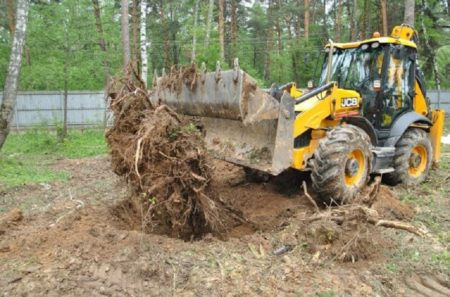 Preparation
Preparation
Marking
Beforehand, it is recommended to create a project on a regular piece of paper. You can order project documentation from professionals. They will take into account the depth of soil freezing and the occurrence of groundwater, and will conduct a geological examination of the soil.
The marking on the construction site is carried out strictly according to the project. Wooden pegs are installed in the corners of the future capital structure. The construction cord is being pulled. Along the perimeter of the house, at a distance of 1.5-2 m, at the intersections, markings are made for columns.
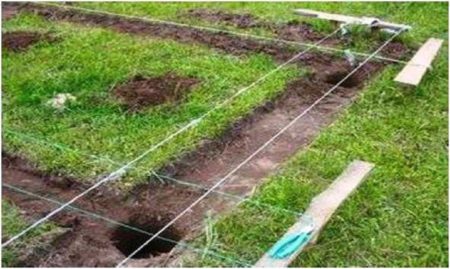 Markup
Markup
Columnar foundation manufacturing technology
The technological process of laying a columnar type of foundation requires a clear sequence of work. It is carried out in several stages.
Well drilling, piling
Step-by-step instructions for creating piles: by marking, wells are drilled with a drill. Depth - more than 0.25 m from the level of soil freezing. Width - 70 mm more than the cross-section of the plastic pipeline.
 Well creation
Well creation
Concreting pipes
Reinforcement of the structure is preliminarily performed. Metal rods are introduced into the plastic. If broadening is expected, they are bent 90 degrees at the end. For the foundation of lightweight buildings, you can simply insert straight rods.
Bars are used, with a section of 10-12 mm, forming the ribs of the frame. Thinner rods are bent into yokes. The rods are fixed to them with a knitting wire. The diameter of the future reinforcing frame should be such that after the installation work, the rods lag behind the pipe by 3 cm.
The filling of the cement-sand composition is carried out in several stages:
- the concreting of the widened heel is carried out by pouring a small amount of concrete and raising the pipe. The solution filling the bag will harden;
- you will get a slight expansion around the perimeter of the future support. Then the pipe cavity is filled to the top with concrete;
- on top of the support element, the stud is attached. It fixes the grillage or wall.
The concrete mix in the pipeline will dry completely in a few days. During this time, the top of the support is regularly wetted. Covered with polyethylene.
 Pouring concrete mortar
Pouring concrete mortar
Upon completion of the work, a wooden or metal grillage is installed on the supporting elements.
Technology of making a pile foundation from asbestos-cement pipes
- Preparation must begin with marking. Remove debris and foreign objects from the construction site, level it if possible and remove the sod. The contours of the future building, corners, intersections of walls are marked with the help of pegs and a rope. The pile installation sites are marked with pegs. To check the perpendicularity of the corners and the correctness of the markings, check the equality of the diagonals.
- They begin to drill wells under the support pillars. This can be done with the help of a drill, and in the absence of it, you can dig holes with a diameter greater than the diameter of the pipes. The depth of the well is 20 cm more than the estimated size of the underground part of the piles, which is necessary for the construction of a sand cushion.
The process of drilling a well under a pile
Arrange a sand cushion 20 cm thick at the bottom of each well, tamp it and spill it with water. After absorbing water, the bottom is lined with roofing material. After that, prepared pipes are installed in the well. If pipes have to be cut to the required size, it is necessary to leave a margin of about 10 cm in height in order to level the height of the supports after completing the foundation.
Installation process of asbestos-cement support pipes
The pipes are leveled, fixed with temporary supports made of wooden blocks. Check the equality of the diagonals again. In areas with a close occurrence of groundwater, pipes are waterproofed with mastic based on bitumen to the ground level. Dry the mastic.
Alignment Process for Asbestos Cement Pipes Using Wood Formwork
- Concrete is prepared: 1 part of cement is mixed with 2 parts of sand, diluted with water to the consistency of a batter, after which 2 parts of fine gravel are poured into the resulting solution. Knead well and pour the base of the pipe 40-50 cm.
- The pipe is raised by 15-20 cm and left until the concrete has completely solidified. This technique will help create a solid support base that is resistant to pushing forces when the soil heaves.
- After the concrete hardens, the well on the outside of the pipe is additionally waterproofed with roofing material and covered with river sand, spilled and rammed, checking the installation by level. Pull a string between them or set a bar and align them horizontally.
The foundation of asbestos-cement pipes is ready
- Fittings are installed inside the pipe: several rods interconnected by transverse wire bridges. The concrete is mixed and the rest of the pipe is poured. To remove air from the solution, pierce it several times with a metal bar.
- After complete drying of the concrete, in two to three weeks, the foundation is ready for further construction. In order to extend its service life, it is recommended to waterproof it with bitumen or polymer materials.
The device of a pile foundation made of asbestos-cement pipes can reduce the cost of construction of a solid foundation for a building several times. However, under too much load, such a foundation may not be strong enough. In this case, it is better to choose another type of foundation, tape or monolithic.
In conclusion, be sure to read about the bored foundation with your own hands.
Columnar foundation construction
Columnar foundations are point supports that are embedded deep into the ground. The distance between the posts varies from 1 to 3 meters, depending on the weight of the building. For a light structure, it is enough to install pillars along the perimeter of the bearing walls. For heavier houses, the columnar foundation looks like equidistant supports throughout the entire area.
To evenly distribute the load, individual support pillars are connected with a grillage, which can be made in the form of a frame-strapping around the perimeter or a reinforced concrete slab laid on the pillars. The depth of the posts and the location of the grillage relative to the soil level varies.
There are columnar foundations in height:
- recessed - built to prevent the building from blowing under the floor;
- low - have a grillage at ground level;
- high - the house is raised above ground level in flooded areas.
The material for the pillars is reinforced concrete or prefabricated piles. Since ready-made piles and their installation are quite expensive, the possibility of using a minimum of inexpensive materials is of interest for budget construction.
Self-construction of a columnar foundation differs little from the technology of building a strip foundation. It also requires the creation of the formwork for pouring the support pillars.
There are several options for implementation:

Today, orange plastic sewer pipes are the best option for permanent formwork for a columnar foundation.
Calculations of the foundation of asbestos-cement pipes
When calculating the foundation of asbestos-cement pipes, the designer should be guided by the size of the depth of soil freezing and, of course, the size of the planned load. By the way, if it is possible to exceed the loads, for example, creating a superstructure, then it makes sense to think about using a foundation support of a different type.
The depth of freezing can be determined on the basis of the data that is in the construction manuals. It should be remembered that the books indicate the freezing depth of clean soil, that is, without the presence of snow cover. In other words, if in the area where the construction is carried out, the snow cover is relatively high, then the size of the freezing depth can be slightly reduced. To the obtained value, add 0.3 - 0.5 meters. The pile heads protrude 0.3 meters above the ground level. If there is a risk of flooding, then they can be made higher.
The diameter of asbestos-cement pipes depends entirely on the mass of the building being erected. For example, for structures such as gazebos, it is sufficient to use asbestos-cement pipes under the foundation with a diameter of 100 mm. For houses, for example, built from logs, it is advisable to use pipes with a diameter of 250 - 300 mm.
The pressure on the foundation of asbestos pipes directly depends on the type of structure and, of course, the material from which the house will be built. When carrying out the calculation, it is necessary to take into account the weight of the roof, insulation, decoration and the equipment that will be installed in the house.
Piles should be installed at the corners of the building and where the load-bearing walls intersect. In addition, they are installed along the perimeter of the building. The installation step must not be more than 1 meter. But if the pressure on one pile is more than 800 kg, then the number of piles will have to be increased, respectively, the step between them will be reduced.
Based on the results obtained, the required number of pipes and fittings should be determined. Two or three rods are installed in one pipe. And of course, it is necessary to take into account the amount of wire that is designed to connect the rods.
Calculating the required amount of concrete, you can use the following algorithm - 10 running meters, pipes with an outer diameter of 100 mm, fit 0.1 cubic meters, in a pipe with a diameter of 200 mm, 0.5 cubic meters of concrete can fit into a pipe of the same length. If the diameter is 300 mm, then a whole cubic meter will fit into it.
The dependence of the choice of the foundation on the characteristics of the soil and the characteristics of groundwater
Consider the possibility of building a foundation from pipes. It should be borne in mind that this is by no means a universal foundation (excluding the pile foundation with screw piles).In the case of complex soils and a large construction weight, such a foundation will not work, you need to build more complex varieties - monolithic slab, monolithic tape, tape from blocks, monolithic pile. Therefore, in order to have absolute confidence in the correct choice of the foundation from the pipes, you need to order a geodetic survey of your site. It will include a conclusion about the soils, their layered location, the depth of groundwater, the depth of soil freezing and the presence of water "lenses" inside the soil.
Geodetic research must certainly precede the design of the future structure and accompany it as it moves forward.
Soils and their combinations
The classification of soils is presented in reference books; for example, in the textbook “Soils. Foundations. Soil characteristics. Choosing the optimal foundation ":
- Rocky soils are, rather, crystalline rock, rock, not earth, and sedimentary rock (dolomites, compressed sandstones, shales, shell rocks, limestones). Any foundation is acceptable, except for a pile foundation (it is difficult to drill a rock).
- Conglomerates - fragments of different types of rocky soils; do not blur and do not change in volume, freezing; any foundation is acceptable.
- Non-rocky soils:
- related - clay and loamy; deeply freeze; able to "float" and move, only heavy types of foundations are suitable;
- unbound - sandy and sandy loam soils; when wet, they tend to move, freeze shallowly; foundations of any type are suitable.
Different soils that can be found on your site
Knowing this list, you can approximately determine the type of your soil and independently: drill a hole with a garden drill and study soil samples from different depths.
As a result of geodetic work, you will receive complete information about the condition of your site
If a soil sample moistened with water can be kneaded like dough, then your soil is loam. If the earth dissolves in water, there is a large percentage of the loamy component in it. If sediment falls, then there is clay at the bottom, and sand above it.
To determine the type of soil, you need to place the sample in a glass of water.
If you have good, stable soil on your site - a rock mass, untouched sandstone, or sedimentary rocks, or sand, or dense loamy soils, then a foundation made of pipes is quite suitable for any light construction such as a frame house, veranda, gazebo, barn. And the foundation made of screw piles is suitable for any building on any soil.
The depth of soil freezing
The freezing depth in central Russia is about one meter, but deviations are possible. The lowest point of the foot of any buried foundation must be below the freezing point of the ground. This most often does not apply to pipes (except for screw piles).
Freezing depth - a factor affecting the depth of the foundation
Ground water level
This is the most important characteristic of soils, and the required type of foundation also directly depends on it.
The groundwater level at the site has a huge impact on the choice of the type of foundation
The foundation of pipes (excluding the pile of screw piles) is applicable only with a low level of groundwater. If this level is high, then other types of foundations should be considered.
However, it is important to consider the water level indicator together with the freezing depth. If the water in the cold season is located at a depth below two meters relative to the freezing point of the soil (you can designate the freezing depth as Z), and the soil is quite dense (clay, sand), then the freezing depth can be ignored
Advantages and disadvantages
When self-erecting a residential or country house, a gazebo, a shed or a terrace, especially on difficult ground, it is important, saving time, effort and money, to get a reliable and functional structure.Therefore, before deciding on a pile foundation made of asbestos-cement pipes, it is necessary to weigh the pros and cons of this supporting structure.
The advantages of a columnar asbestos foundation are:
- applicability in difficult areas,
- low cost of consumables,
- low consumption of cement,
- speed of construction,
- possibility of installation with a small set of tools,
- reduction of the volume of earthworks,
- resistance to moisture, temperature extremes,
- chemical and biological inertness,
- absence of corrosion of underground and above-ground parts of the foundation,
- protection of the building from flooding.
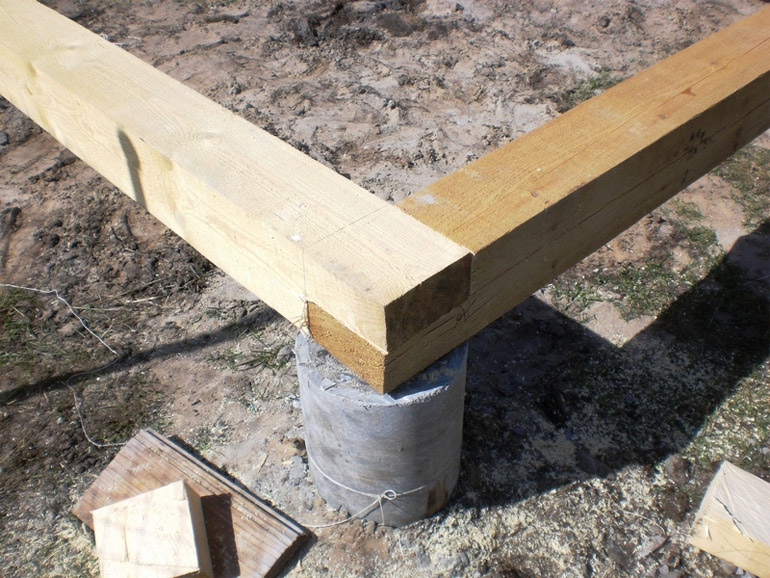
However, asbestos-cement pipes and supports from them have serious disadvantages:
- low bearing capacity, insufficient for the construction of residential buildings from heavy building materials, houses of a large area and number of storeys;
- the impossibility of equipment under the house of a basement or cellar;
- for a large number of foundation pillars, many wells will be required, the digging of which without a drill is comparable in labor costs to laying a ditch for a strip foundation;
- errors in calculations or installation will lead to the fact that the soil will squeeze out the piles, since the asbestos pipe does not have adhesion to the soil.
Reinforcement layer formation
The installation of a reinforcing layer is mandatory for the foundation, since it distributes the load along the column, and in the presence of heaving or loose soils, it excludes deformation or damage to the structure. Structurally, it consists of four reinforcing bars with a diameter of 8-12 mm, located in cross-section at the corners of a square, with a thick wire ligation along the length of the post with an interval of 1-1.2 m.
The length of the side of the square of the piping is determined taking into account the diameter of the pipe: the reinforcement should not touch its walls and be at a distance of 20-30 mm. When pouring concrete, the reinforcing structure must be completely immersed in the solution and not in contact with the surface of the PVC pipe.
The reinforcement cage at the level of the sole should have an expansion in the form of ends bent at right angles, and its length should be equal to the height of the pipe. It is formed on a flat surface, and then carefully lowered into the PVC pipe with alignment.
What is the peculiarity of the foundation made of asbestos pipes
From asbestos-cement pipes, a foundation of a columnar, or pile, type is erected, making original legs for the future structure - pillars, or piles that go deep into the soil.
A feature of such a foundation is the installation of piles under key points of the structure: corners, zones of intersection of walls.
A distinctive feature of the pile asbestos-cement foundation is the filling of hollow asbestos pipes with cement mortar with additional reinforcement. As a result, the pillars of the supports are strong and resistant to soil pressure and able to withstand the weight of the erected structure.
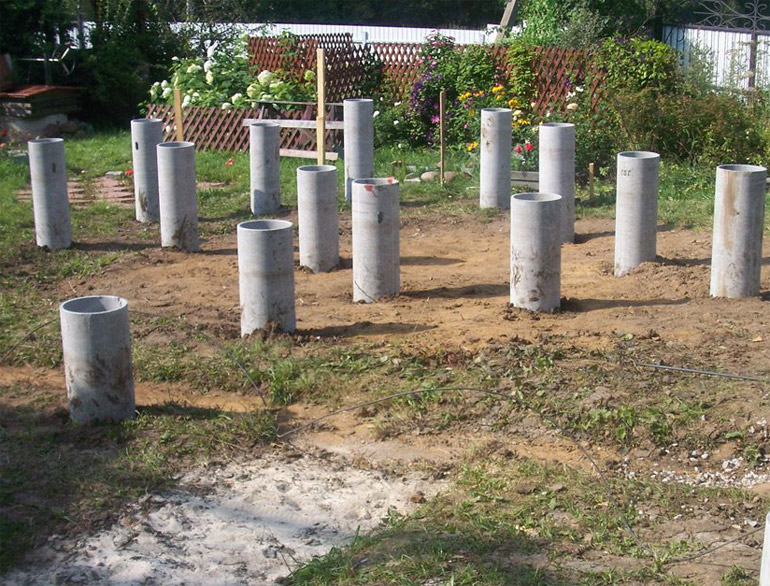
Such a structure of the supporting structure is relevant in cases where it is impossible or impractical to construct a foundation of a slab or tape type:
- When erecting outbuildings, country houses and frame houses that do not have a cellar, baths. Lightweight buildings for various purposes do not need to equip a support tape around the perimeter, especially since it is impractical to pour a monolithic slab under them.
- On difficult ground or in cold regions where excavation is expensive. On unstable ground, prone to crumbling, trenching and foundation installation is impossible without formwork equipment. In cold regions, where the ground does not thaw even in summer, as well as on rocky ground, the risk of crumbling is lower, but the work itself is much more difficult.
- With a high level of groundwater or when the structure is located near bodies of water that are prone to spills. In wet soil, the strip and monolithic foundation will constantly be in contact with water, gradually collapsing and sinking into cavities washed out by underground flows.
DIY installation of a columnar foundation
Anyone can build a columnar foundation from sewer pipes
a person, subject to the construction technology:
- Design. At this stage, the number of supports, their location is calculated, the depth of immersion of the pillars is determined, and the site is marked.
- Preparation for work. First, you need to cut the blanks into pieces of the required length, prepare the lower part of each blank for concreting the heel. It is also necessary to prepare anchor studs, which will be poured into the upper part of the support to connect the foundation with the grillage.
- Frame fabrication. To increase the bearing capacity of the pillars, it is necessary to make a reinforcing cage, for which ribbed reinforcement bars are used. To reinforce the expansion, the rods are bent in the shape of the letter "L".
- Well drilling. With the help of a hand drill, it is necessary to drill wells in accordance with the diameter of the sewer pipe. The depth of the well depends on the level of freezing of the soil, it is necessary to go down below this mark by 20-25 cm.
- Expansion at the bottom of the wells. Using special nozzles for a hand drill, an expansion is made at the bottom of each recess. This increases the stability of the posts.
- Prepared products are inserted into the well and an expansion is formed. To do this, concrete mortar is poured into the pipe and the future support is slightly raised. Before fastening, each plastic post is vertically aligned using a building level. After that, from the outside, they are covered with sand, crushed stone and earth.
- Aligning the supports. All sewer piles must be of the same height. To do this, they beat off the horizontal using a laser level, pull the construction cord and cut each support at the level with a grinder.
Reinforcement and concreting
Reinforcement. The prepared frame made of reinforcing rods is inserted into the pipe. The bent rods are turned to the sides to strengthen the expanded base of the pillar.
Concreting. The prepared post must be filled with concrete mortar. Concrete is fed in small portions, constantly piercing the mixture with a thin rod to compact
In doing so, care should be taken to avoid damaging the plastic product. In the upper part of each support, an anchor pin is installed to secure the grillage.
It is very important to build a foundation from sewer pipes with your own hands in accordance with construction technology. Its violation can lead to negative consequences:
- Exceeding the permissible load on plastic supports leads to their destruction. Additional strengthening of the pillars helps to solve the problem.
- Under heavy load, the pillars can fall into the ground. In this case, the pipe supports are raised to the desired level and fastened to each other with reinforcing rods.
Types of columnar bases and their features
The many different types of foundations present new builders with a difficult choice. The best combination of ease of manufacture and reliability is possessed by columnar foundations. Currently, the following types are used in construction:
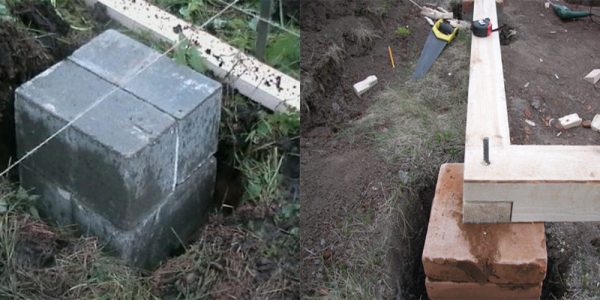
Types of columnar foundations
- Columnar brick foundations are square pillars made from standard building bricks, partially buried in the ground. The advantages of this type are the availability of the materials used and the ease of installation, which makes them quite common in private construction. The disadvantage of this option is the low bearing capacity of brick posts, which limits their use for the construction of light one-story buildings, such as gazebos, verandas and terraces, country houses.
- A columnar foundation of foundation blocks is more perfect. It is made from separate rectangular supports.The main material, as the name suggests, is small concrete blocks purchased from specialized construction sites or made on their own. Unlike the brick version, this type has greater strength, which contributes to its installation under one-story houses made using frame technology.
- A columnar foundation made of metal pipes can be attributed to both columnar and pile foundations. For its manufacture, steel pipes of a sufficiently large diameter are used, buried in the ground by 1.5 meters or more. The high strength of the supports and their protection against corrosion is achieved by additional concreting of the internal cavity, which will be described in more detail below.
When making a columnar foundation from metal pipes with your own hands, as well as other types of bases, you should remember the following rules:
- The total bearing capacity of the entire structure support is made up of the bearing capacity of each element, calculated on the basis of the materials used, the depth of occurrence, the characteristics of the soil at a particular place of construction work;
- Pipes for the foundation must be placed with a step not exceeding 2.5 meters. It is imperative that there are supports under the junction of the load-bearing walls and partitions, as well as under the load-bearing partitions with the above installation interval.
The process of building a foundation from plastic pipes: stages
The principle of building a house is not very different from what material is planned for creating pillars. Therefore, we will tell you how the construction process is carried out in general, along the way indicating important details:
- Creating an estimate and a project, making calculations, purchasing all the necessary materials.
- Markup. On the site, in accordance with the created project, they mark the places where the pillars will be located. As a rule, they are placed along the load-bearing walls and in those places where they intersect, with a step of 1.5-2 m. The foundation of plastic pipes is also erected according to this principle.
- Excavation. Again, all work must be carried out according to the markings applied. In the ground, you need to make the supports that are needed for the planned columnar foundation. Basically, for this purpose, special equipment is used - a drill.
- Calculation of the depth as well as the diameter of the pillars. This factor is calculated individually, depending on the weight of the house, as well as the geological situation on the land. For example: if it is planned to erect an ordinary building for living, the wells are equal to a diameter of 150-250 mm.
- Arrangement of a pillow. At this stage, at the bottom of each hole made earlier, it is necessary to fill in about 15 cm of a layer of sand or gravel. Such measures are necessary in order to ensure that the uniform transfer of the load to the ground is ensured.
- Installation of pipes. If you install PVC pipes for the foundation of a house, it is worth remembering that they simultaneously serve as formwork, as well as waterproofing. The product must be inserted into the well until it stops.
It is worth repeating that if you are going to build a PVC structure, there will be enough sewer pipes in this case. However, we must not forget that plastic is not highly resistant, despite the fact that it does not corrode. Therefore, it is better to use these types of foundations for the construction of small utility rooms.
